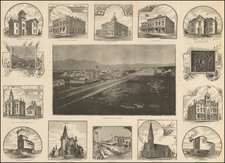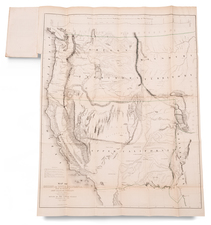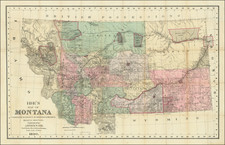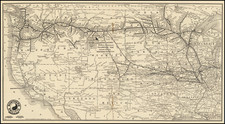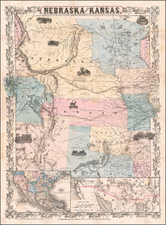Early cross section showing the workings of the Kendall Consolidated Gold Mines, drawn by Draughtsman D.H. Foreman of Denver.
Located in near the Ghost town of Kendall in the Mocassin Mountains of Montana, about 15 miles north of Lewiston, Montana.
The Kendall mine in section 31 T18N, R18E was originally claimed in 1898 by W. C. Draper and W. C. Kendall in conjunction with their Santiago claim. But when they came to stake it, they decided to let the claim go. Instead Charlie Allen located the Leaking and other claims on the ground and gave Tom Riser half interest for digging a ten foot hole on one of them. In November of 1900, Harry T. Kendall bought out Tom Riser's interest for $150, took out a six month bond on Allen's half for $500 and bought the adjacent Klondike claim for $1,500. Two men were put working on the property for the life of the bond. After the bond was taken up, Kendall had a 50 ton cyanide mill erected to work some of the ore. This was the first such mill in the district. It ran successfully and produced $2400 in gold bullion by year's end.
Late in the fall of 1900, Kendall's success was noted by major mining companies. When Kendall was asked how much he would sell the company for, he jokingly replied half a million dollars. The questioner represented Finch and Campbell of Spokane and he advised the amazed Kendall to settle for $460,000 and 10% interest. Soon thereafter, Kendall bonded the 12 claim property to Finch and Campbell retaining a one-tenth interest in the new Kendall Gold Mining Company. In March of 1901, Henry Parent arrived in camp; he was hired to tear down the original mill and erect a 500-ton mill on the same site. Water from Big Warm Spring on the Horseshoe Bar ranch was run two miles in a ditch to connect with a 200 horsepower / 7,000 volt powerplant which powered the mine and mill. A Pelton wheel also turned a 150 horsepower pump that forced water up a six mile pipe to a storage tank at the new mill. When construction was complete Allen was placed in charge of the mill. He also built a boarding house for 40 workers, a residence for himself and a stable.
By July 1901, the mill was working 100 tons of ore a day with a return of $8.00 per ton from unsorted ore. Ore was extracted from open cuts, adits and an incline shaft. Giant stopes were excavated that fed the ore through chutes to mill level without any handling. The ore body was known to extend 750 feet and to a depth of over 400 feet. In 1905 or 1906 a 600 foot vertical shaft was sunk and a 150 horsepower double-drum electric hoist was installed. A 75 horsepower compressor powered 8 drills. In the first five years of operation the mill turned out $2,500,000 in gold bullion and paid out $1,000,000 in dividends while paying for all surface and mine developments. The Kendall Gold Mining Company continued operation of the mine until 1913; an estimated 700,000 tons of ore was worked to provide dividends of $1,450,000. The mine ultimately reached a depth of 550 feet. Total production prior to 1913 was more than 700,000 tons of ore which reportedly resulted in $1,450,000 in dividend distributions.
When the mine was sold to the Barnes-King Development Company in 1915, ore was exhausted to a depth of 560 feet while the mine extended another 180 feet down. In one incident involving the collapse of a large square-set stope, a large amount of oxidized ore was lost. The mine was operated by lessees from 1913 to 1921. Their activity was primarily in the upper levels and the open pit. The shaft was, however, sunk an additional 63 feet.
The Kendall mine is listed in the Montana Mining Index from 1903 to 1923 and in 1934. The mine is listed extensively in the mining literature from 1903 to 1920 and in 1939.









